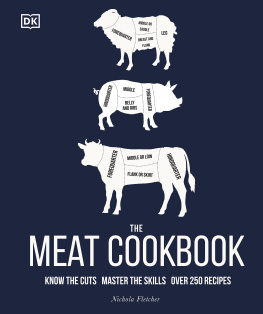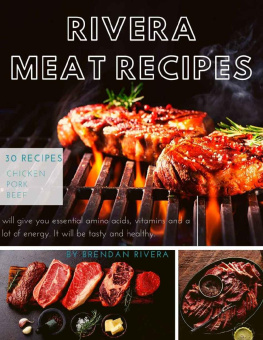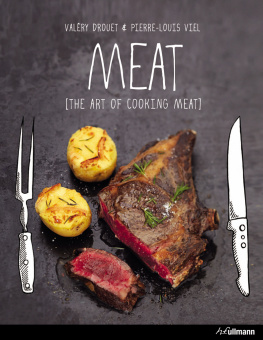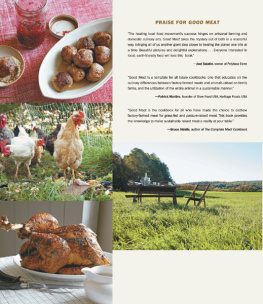



Published in 2010 by Stewart, Tabori & Chang
An imprint of ABRAMS
Text copyright 2010 Deborah Krasner
Photographs copyright 2010 Marcus Nilsson
Illustrations copyright Elizabeth Krasner
All rights reserved. No portion of this book may be reproduced, stored in a retrieval system, or transmitted in any form or by any means, mechanical, electronic, photocopying, recording, or otherwise, without written permission from the publisher.
Library of Congress Cataloging-in-Publication Data
Krasner, Deborah.
Good meat : the complete guide to sourcing and cooking sustainable meat / Deborah Krasner.
p. cm.
Includes bibliographical references and index.
ISBN 978-1-58479-863-7 (alk. paper)
1. Cookery (Meat) 2. Cookery (Poultry) 3. Sustainable livingUnited States. 4. Meat industry and tradeEnvironmental aspectsUnited States.
I. Title.
TX749.K68 2010
641.66dc22 2009047925
Editor: Luisa Weiss/Natalie Kaire
Designer: Susi Oberhelman
Production Manager: Tina Cameron
Stewart, Tabori & Chang books are available at special discounts when purchased in quantity for premiums and promotions as well as fundraising or educational use. Special editions can also be created to specification. For details, contact specialsales@abramsbooks.com or the address below.

115 West 18th Street
New York, NY 10011
www.abramsbooks.com


Husbandry is the name of all the practices that
sustain life by connecting us conservingly to our places
and our world; it is the art of keeping tied all
the strands in the living network that sustains us.
Wendell Berry
T his book is deeply rooted in my life in Vermont for the past twenty-odd years and reflects the values Ive learned here. It is a privilege to be part of a community that honors farmers who grow good food.
Many of those farmers have given me information, opened their farms to me, and provided meat and/or animal husbandry advice. These include Rod Hewitt, Lucas Fletcher, Ping Ting, and Asa Goodband. Some of my sources for local meats include Fowl Mountain Farm and Rabbitry, who raise rabbit and pheasant; Martha Miller of Dwight Miller Orchard, who raises pastured chicken; and Judy Sopenski of Not Your Ordinary Farm, who raises lamb. I have also learned from Bekah Murchison of Fair Winds Farm, who hosted the poultry-processing workshop; and Lili Bookwalter of Ledgewood Farm Icelandics, who breeds the lambs I raise for meat.
Four authors have influenced much of my thinking over the last few years: Wendell Berry, who has written so movingly about place, agriculture, personal responsibility, and sustainability; Eric Schlosser, who illuminated the connections between industrial food and factory farming; Michael Pollan, whose writing introduced me to Joel Salatin and taught so many of us about feedlot beef; and Barbara Kingsolver, who, along with her family, walks the walk.
During the process of writing this book, a number of people read parts of the manuscript and offered their help. I am most grateful to Michael Gourlay, owner of Hardwick Beef, for reading the beef chapter, making suggestions and comments, and getting me some of the harder-to-source beef cuts I needed. Thank you as well to Shannon Hayes for reading the lamb chapter and commenting most helpfully.
Adam Tiberio was invaluable in helping me create the cut sheet guides that offer consumers a logical series of choices, primal by primal. Jake Dickson, of Dicksons Farmstand Meat, graciously allowed us to photograph Adam in the shop, breaking down meat to illustrate this book.
Chefs Choice gave me a meat slicer and sausage grinder, and both were extremely useful pieces of equipment in the creation of this book. KitchenAid has long been a great source of support, and I am glad once again to acknowledge their help with equipment large and small.
My friend Jessie Haas and her parents, Bob and Pat Haas, have offered country wisdom born of their long experience raising, cooking, and eating their own meat.
My valiant recipe testers have been incredible, cooking carefully at home and letting me know what works and what is confusing. I, of course, tested every recipe as I developed it, often repeatedly. But these testers took the printed recipes and tried them again with their own grass-fed and pastured meats, letting me know where they felt the writing or the dish needed help. Their e-mails have given me belly laughs, anxiety, joy, and thankfulness. To Sarah Strauss, Valerie Wright, and Melissa Pasanen, I raise my glass and offer heartfelt thanks.
My family, as ever, have been stalwart supporters, offering their palates and ideas without stinting. Youll see recipes from them in this book, and youll also benefit from their behind-the-scenes comments that helped me create the dishes. Thank you to Abby Krasner Balbale for tasting, thinking, writing, conceptual, and research help; to Musab Balbale for some great recipes; to Lizzie Krasner for her fine illustrations, and commenting, cooking, testing, organizing the kitchen, and editing; and to my husband, Michael Krasner, who greets each meal with anticipation, eats it with joy, and then cleans the kitchen.
Lizzies friend (and now ours) James Kenji Lopez-Alt has visited and cooked with me on several occasions, each time teaching me how to fearlessly break down large animal parts and cook them with pleasure. Most recently, Kenji helped us process the years worth of poultry we raised last summer. Thank you, Kenji, for being part of our kitchen life.
For the past two years, my culinary family (known as the Creampuffs) has been a group of food professionals I cook with monthly. We get together to tackle ambitious dishes, to understand unfamiliar techniques, and to enjoy the company of other passionate cooks and eaters. Two of them, in particular, have generously helped me to develop some of the recipes in this book, and their support has kept me going. A big thank-you and hugs to Marshall Brewer and Tuk Long; I hope well keep on cooking and learning together for a very long time.
No book is born from the forehead (or palate) of its author, and cookbooks, especially, grow as much from other people and their books as from a sense of place or taste. Ive included a bibliography to acknowledge the books that inspired me and pushed me in the direction of different dishes. When Ive found other peoples recipes that are un-improvable, Ive cited their authors in the headnotes, even as Ive adapted their recipes for grass-fed meat. Many of the cookbooks in the bibliography are particular favorites; if nothing else, I hope to introduce you to some wonderful food writers.
Next page















